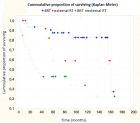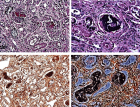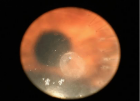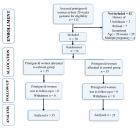Abstract
Case Report
Anal cancer - impact of interstitial brachytherapy
Regináčová K*, Kubecová M, Vránová J and Šejdová M
Published: 01 February, 2021 | Volume 5 - Issue 1 | Pages: 001-004
We evaluated a total of 115 patients diagnosed with anal cancer, who were treated at our clinic from 1995 to 2012. Their average age was 61 years, most often were diagnosed in stages II and III, in most cases it was a squamous cell carcinoma located in the anal canal. The mean follow-up was 83 months (minimum 1 month and maximum 240 months). We combined external radiotherapy with boost of brachytherapy or boost of external radiotherapy and possibly a combination of both boosts. Half of the patients received concomitant chemotherapy. We specifically evaluated local tumor regression, overall survival and the impact to therapeutic effect of the chosen irradiation technique. Complete regression was achieved in 92 patients, partial regression in 21 patients. Overall survival, regardless of stage, was 80% 3-year, 74% 5-year and 67% 10-year. The age of patients, the size of their own primary tumor and the therapeutic method used had a statistically significant effect on survival - especially the importance of brachytherapy was irreplaceable.
Read Full Article HTML DOI: 10.29328/journal.jro.1001034 Cite this Article Read Full Article PDF
Keywords:
Anal cancer; Radiotherapy; Brachytherapy
References
- Gryc T, Ott O, Putz F, Knippen S, Raptis D, et al. Interstitial brachytherapy as a boost to patients with anal carcinoma and poor response to chemoradiation: Single-institution long-term results. Brachytherapy. 2016; 15: 865-872. PubMed: https://pubmed.ncbi.nlm.nih.gov/27720203/
- Heilmann et al. Poster - Image guided boost brachytherapy for anal cancer: tumor and functional outcome, 2018, Radiotherapy and Oncology. 2018. https://www.postersessiononline.eu/173580348_eu/congresos/ESTRO37/aula/-V_252_ESTRO37.pdf
- Frakulli R, Buwenge M, Cammelli S, Macchia G, Farina E, et al. Brachytherapy boost after chemoradiation in anal cancer: a systematic review. J Contemp Brachytherapy. 2018; 10: 246-253. PubMed: https://www.ncbi.nlm.nih.gov/pmc/articles/PMC6052386/
- Oehler-Jänne C, Seifert B, Lütolf UM, Studer G, Glanzmann C, et al. Clinical outcome after treatment with a brachytherapy boost versus external beam boost for anal carcinoma. Brachytherapy. 2007b; 6: 218-226.
- Moureau-Zabotto L, Ortholan C, Hannoun-Levi JM, Teissier E, Cowen D, et al. Role of Brachytherapy in the Boost Management of Anal Carcinoma With Node Involvement (CORS-03 Study). Int J Radiat Oncol. 2013b; 85: e135-e142.
- Lestrade L, De Bari B, Pommier P, Montbarbon X, Lavergne E, et al. Role of brachytherapy in the treatment of cancers of the anal canal. Strahlentherapie Und Onkologie. 2014; 190: 546-554.
- Carvalho C, Glynne-Jones R. Challenges behind proving efficacy of adjuvant chemotherapy after preoperative chemoradiation for rectal cancer. Lancet Oncol. 2017; 18: e354-e363. PubMed: https://pubmed.ncbi.nlm.nih.gov/28593861/
- Saarilahti K, Arponen P, Vaalavirta L, Tenhunen M. The effect of intensity-modulated radiotherapy and high dose rate brachytherapy on acute and late radiotherapy-related adverse events following chemoradiotherapy of anal cancer. Radiother Oncol. 2008; 87: 383-390. PubMed: https://pubmed.ncbi.nlm.nih.gov/18501454/
Figures:

Figure 1
Similar Articles
-
A Short Synthesis Concerning Biological Effects and Equivalent Doses in RadiotherapyCyril Voyant*,Daniel Julian. A Short Synthesis Concerning Biological Effects and Equivalent Doses in Radiotherapy. . 2017 doi: 10.29328/journal.jsmt.1001036; 1: 039-045
-
Hyperthermia and Breast cancer: A short reviewBora Uysal*. Hyperthermia and Breast cancer: A short review. . 2017 doi: 10.29328/journal.jro.1001011; 1: 079-082
-
Anal cancer - impact of interstitial brachytherapyRegináčová K*,Kubecová M,Vránová J,Šejdová M. Anal cancer - impact of interstitial brachytherapy. . 2021 doi: 10.29328/journal.jro.1001034; 5: 001-004
-
8 Gy single dose radiotherapy for bone metastasis in COVID-19 pandemia period: ReviewBora Uysal*,Hakan Gamsız,Ferrat Dincoglan,Omer Sager,Selcuk Demiral ,Murat Beyzadeoglu. 8 Gy single dose radiotherapy for bone metastasis in COVID-19 pandemia period: Review. . 2020 doi: 10.29328/journal.jro.1001032; 4: 005-007.
-
Localized intrapulmonary desmoplastic mesothelioma: A case reportMeng Liu,Kaifu Wu,Yongming Tan*. Localized intrapulmonary desmoplastic mesothelioma: A case report. . 2019 doi: 10.29328/journal.jro.1001030; 3: 014-016.
-
Adaptive planning and toxicities of uniform scanning proton therapy for lung cancer patientsYuanshui Zheng*,Hardev Singh,Suresh Rana,Gary Larson,Prabhu Kiran,Lucius Doh,James Wong. Adaptive planning and toxicities of uniform scanning proton therapy for lung cancer patients. . 2018 doi: 10.29328/journal.jro.1001023; 2: 055-061
-
Adrenal insufficiency in Bilateral Adrenal Metastasis implemented SBRTYasemin Benderli Cihan*. Adrenal insufficiency in Bilateral Adrenal Metastasis implemented SBRT. . 2018 doi: 10.29328/journal.jro.1001016; 2: 009-011
-
Which is the best? Palliative Radiation Therapy to Spleen or SplenectomyYasemin Benderli Cihan*. Which is the best? Palliative Radiation Therapy to Spleen or Splenectomy. . 2018 doi: 10.29328/journal.jro.1001015; 2: 003-008
-
Autologous grafts in radiotherapy received breast cancer patientsYasemin Benderli Cihan*. Autologous grafts in radiotherapy received breast cancer patients. . 2018 doi: 10.29328/journal.jro.1001014; 2: 001-002
-
Radiation-induced salivary gland damage/dysfunction in head and neck cancer: Nano-bioengineering strategies and artificial intelligence for prevention, therapy and reparationZiyad S Haidar*. Radiation-induced salivary gland damage/dysfunction in head and neck cancer: Nano-bioengineering strategies and artificial intelligence for prevention, therapy and reparation. . 2022 doi: 10.29328/journal.jro.1001044; 6: 027-044
Recently Viewed
-
Gentian Violet Modulates Cytokines Levels in Mice Spleen toward an Anti-inflammatory ProfileSalam Jbeili, Mohamad Rima, Abdul Rahman Annous, Abdo Ibrahim Berro, Ziad Fajloun, Marc Karam*. Gentian Violet Modulates Cytokines Levels in Mice Spleen toward an Anti-inflammatory Profile. Arch Asthma Allergy Immunol. 2024: doi: 10.29328/journal.aaai.1001034; 8: 001-006
-
Impact of Latex Sensitization on Asthma and Rhinitis Progression: A Study at Abidjan-Cocody University Hospital - Côte d’Ivoire (Progression of Asthma and Rhinitis related to Latex Sensitization)Dasse Sery Romuald*, KL Siransy, N Koffi, RO Yeboah, EK Nguessan, HA Adou, VP Goran-Kouacou, AU Assi, JY Seri, S Moussa, D Oura, CL Memel, H Koya, E Atoukoula. Impact of Latex Sensitization on Asthma and Rhinitis Progression: A Study at Abidjan-Cocody University Hospital - Côte d’Ivoire (Progression of Asthma and Rhinitis related to Latex Sensitization). Arch Asthma Allergy Immunol. 2024: doi: 10.29328/journal.aaai.1001035; 8: 007-012
-
Why Down-managing Backlog Forensic DNA Case Entries MattersJH Smith*, JS Horne. Why Down-managing Backlog Forensic DNA Case Entries Matters. J Forensic Sci Res. 2024: doi: 10.29328/journal.jfsr.1001056; 8: 001-008
-
Reduced Pain Scores during Indocyanine Green Lymphography by using a Different Preparation FormulaJingjing Wen,Zhegang Zhou*,Abdelhakim Ezzat Marei,Longbiao Yu,Fanbin Meng,Lifang Duan,Yingfeng Xiao,Hui Zeng,Shengxiang Wan. Reduced Pain Scores during Indocyanine Green Lymphography by using a Different Preparation Formula. J Radiol Oncol. 2025: doi: 10.29328/journal.jro.1001078; 9: 041-045
-
Analysis and Comparison of Social Media Applications Using Forensic Software on Mobile DevicesHüseyin Çakır*, Merve Hatice Karataş . Analysis and Comparison of Social Media Applications Using Forensic Software on Mobile Devices. J Forensic Sci Res. 2024: doi: 10.29328/journal.jfsr.1001065; 8: 058-063
Most Viewed
-
Evaluation of Biostimulants Based on Recovered Protein Hydrolysates from Animal By-products as Plant Growth EnhancersH Pérez-Aguilar*, M Lacruz-Asaro, F Arán-Ais. Evaluation of Biostimulants Based on Recovered Protein Hydrolysates from Animal By-products as Plant Growth Enhancers. J Plant Sci Phytopathol. 2023 doi: 10.29328/journal.jpsp.1001104; 7: 042-047
-
Sinonasal Myxoma Extending into the Orbit in a 4-Year Old: A Case PresentationJulian A Purrinos*, Ramzi Younis. Sinonasal Myxoma Extending into the Orbit in a 4-Year Old: A Case Presentation. Arch Case Rep. 2024 doi: 10.29328/journal.acr.1001099; 8: 075-077
-
Feasibility study of magnetic sensing for detecting single-neuron action potentialsDenis Tonini,Kai Wu,Renata Saha,Jian-Ping Wang*. Feasibility study of magnetic sensing for detecting single-neuron action potentials. Ann Biomed Sci Eng. 2022 doi: 10.29328/journal.abse.1001018; 6: 019-029
-
Pediatric Dysgerminoma: Unveiling a Rare Ovarian TumorFaten Limaiem*, Khalil Saffar, Ahmed Halouani. Pediatric Dysgerminoma: Unveiling a Rare Ovarian Tumor. Arch Case Rep. 2024 doi: 10.29328/journal.acr.1001087; 8: 010-013
-
Physical activity can change the physiological and psychological circumstances during COVID-19 pandemic: A narrative reviewKhashayar Maroufi*. Physical activity can change the physiological and psychological circumstances during COVID-19 pandemic: A narrative review. J Sports Med Ther. 2021 doi: 10.29328/journal.jsmt.1001051; 6: 001-007

HSPI: We're glad you're here. Please click "create a new Query" if you are a new visitor to our website and need further information from us.
If you are already a member of our network and need to keep track of any developments regarding a question you have already submitted, click "take me to my Query."

















































































































































